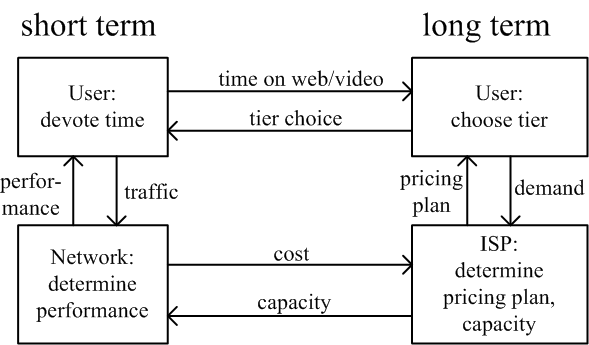 |
Scott Jordan | |
|
|
 Thirty years of networking research on Quality of Service (QoS) has resulted in standards that have been incorporated into routers of all shapes and sizes. And yet, despite all of this work, use of QoS is very limited. Internet Service Providers (ISPs) have implemented QoS to support their own voice and video services, but do not offer QoS to their subscribers for use by any other Internet applications. ISPs have not incorporated QoS into their interconnection agreements, and hence end-to-end QoS is not available. The limited deployment of QoS has ignited vigorous debate over Net Neutrality, which has become the most contentious telecommunications public policy issue in decades.
Thirty years of networking research on Quality of Service (QoS) has resulted in standards that have been incorporated into routers of all shapes and sizes. And yet, despite all of this work, use of QoS is very limited. Internet Service Providers (ISPs) have implemented QoS to support their own voice and video services, but do not offer QoS to their subscribers for use by any other Internet applications. ISPs have not incorporated QoS into their interconnection agreements, and hence end-to-end QoS is not available. The limited deployment of QoS has ignited vigorous debate over Net Neutrality, which has become the most contentious telecommunications public policy issue in decades.
End-to-end QoS deployment requires an interdisciplinary approach that integrates network architecture, economics, and law. Internet architecture has not adequately considered the economic motivations of ISPs; QoS will be deployed and used only when there is a business case for it. The network economics literature has only modeled network access, not QoS. Law will dictate what ISPs can do; it may make QoS illegal, may allow QoS but prohibit charging for it, or may allow ISPs to not offer QoS to competitors. This project will address the lack of QoS availability to applications, the lack of availability of end-toend QoS, and the effects of possible net neutrality laws.
Service Tier Design
The initial work is focused on how Internet Service Providers design tier rates, tier prices, and network capacity. Internet Service Provider design of service tiers are modeled and analyzed, based on demand for web browsing and video streaming. A basic model that considers user willingness to pay, network capacity, and application performance is formulated to determine when multiple tiers maximize profit. An extended model that also considers the time that users devote to each application is formulated to determine the optimal network capacity, tier rates, and tier prices. We show that an Internet Service Provider may simplify tier and capacity design by allowing its engineering department to set network capacity, its marketing department to set tier prices, and both to jointly set tier rates. Numerical results are presented to illustrate the magnitude of the decrease in profit compared to the optimal profit resulting from such a simplified design.
ISP Service Tier Design (with W. Dai), IEEE/ACM Transactions on Networking, vol. 24 no 3, June 2016, pp. 1434-1447.
Data Caps
The next work is focused on how ISPs choose data caps and the resulting impact on users. We propose models to analyze the effect of data caps upon Internet subscribers. Novel utility functions that consider the time users devote to Internet applications and the opportunity cost of a user’s free time are designed for web browsing and video streaming. A monopoly ISP is presumed to maximize its profit by controlling tier prices, tier rates, data caps and overage charges in a basic tier targeting web browsing service and a premium tier targeting video streaming service. We show how users fall into five categories: non-Internet subscribers, basic tier subscribers, premium tier subscribers unaffected by a data cap, premium tier subscribers who are capped but do not choose to exceed the cap, and premium tier subscribers who exceed the cap and pay overage charges. When data caps are used for profit maximization, we find that the monopoly ISP has the incentive to keep the basic tier price and basic tier rate unchanged, to increase the premium tier rate, and to reduce the premium tier price. The ISP also has the incentive to set smaller caps and higher overage charges than when caps are used only to ensure that heavy users pay for their usage. Based on the change in the tiered pricing plan, we give analytical and numerical results to show the changes in user tier choice, user surplus and social welfare.
This paper is intended for people with a background in communications policy:
How do ISP Data Caps Affect Subscribers? (with W. Dai), Research Conference on Communication, Information and Internet Policy (TPRC), Arlington, Virginia, September 2013.
This paper is intended for people with a technical background in networking:
The Effect of Data Caps upon ISP Service Tier Design and Users (with W.Dai), ACM Transactions on Internet Technology, vol. 15 no. 2, June 2015.
The next work is focused on how data caps affect competition between a cable ISP and a DSL ISP. Utility is a function of users’ relative interest, time devoted to each application, and application performance. Users maximize surplus by making ISP subscription choices and by controlling the time devoted to Internet activities. ISPs maximize profit by competing through tier prices, tier rates, network capacities, data caps and overage charges. We illustrate how users’ utilities are affected by data caps, and the resulting impact upon ISP market shares. The initial incentives for both ISPs to update tier prices and tier rates are predicted. The final Nash equilibrium with data caps is analyzed through simulation, and compared to the Nash equilibrium without data caps. We find that a DSL ISP may not set data caps, and that the use of data caps may thus result in an advantage for a cable ISP over a DSL ISP.
The Impact of Data Caps on ISP Competition (with W. Dai and J. Baek), IEEE International Conference on Game Theory for Networks (GameNets), Beijing, China, November 2014.
The next work is a critical survey of the literature on data caps. Proponents and opponents of data caps make conflicting claims about the effect of data caps on prices, network capacity and speeds, subscription, congestion, and consumer surplus. In this paper, we survey the academic literature on data caps and analyze the relationship between the characteristics of each paper's model or data and the paper's results. We find that model or data assumptions about service differentiation, purpose of the data cap, and amount of competition strongly influence each paper's results. Consequently, conclusions about the effect of data caps are often limited to certain types of service providers (fixed or mobile) and/or to certain types of data caps (heavy-users or profit-maximizing). We find that most proponents' claims about data caps in fixed broadband service are incorrect, and that most proponents' claims about data caps in mobile broadband service are likely to be correct if and only if data caps increase competition. We also discuss how data caps may be evaluated under the FCC's 2015 Open Internet Order. We find that heavy-users caps on mobile broadband service are likely to satisfy the Order's rules, that profitmaximizing caps on mobile broadband service may or may not satisfy the rules, and that caps on fixed broadband service are unlikely to satisfy the rules.
A Critical Survey of the Literature on Broadband Data Caps, Telecommunications Policy, vol. 41 no. 9, October 2017, pp. 813-837..
Portions of this work were supported by NSF. Any opinions, findings, conclusions or recommendations expressed in this material are those of the author(s) and do not necessarily reflect the views of the National Science Foundation or IEEE. This material is presented to ensure timely dissemination of scholarly and technical work. Copyright and all rights therein are retained by authors or by other copyright holders. All persons copying this information are expected to adhere to the terms and constraints invoked by each author's copyright. One print or electronic copy may be made for personal use only. Permission must be obtained from the copyright holder for systematic or multiple reproduction, distribution to multiple locations via electronic or other means, duplication of any material in these papers for a fee or for commercial purposes, modification of the content of these papers, reprinting or republishing of this material for advertising or promotional purposes or for creating new collective works for resale or redistribution to servers or lists, and to reuse any copyrighted component of this work in other works.